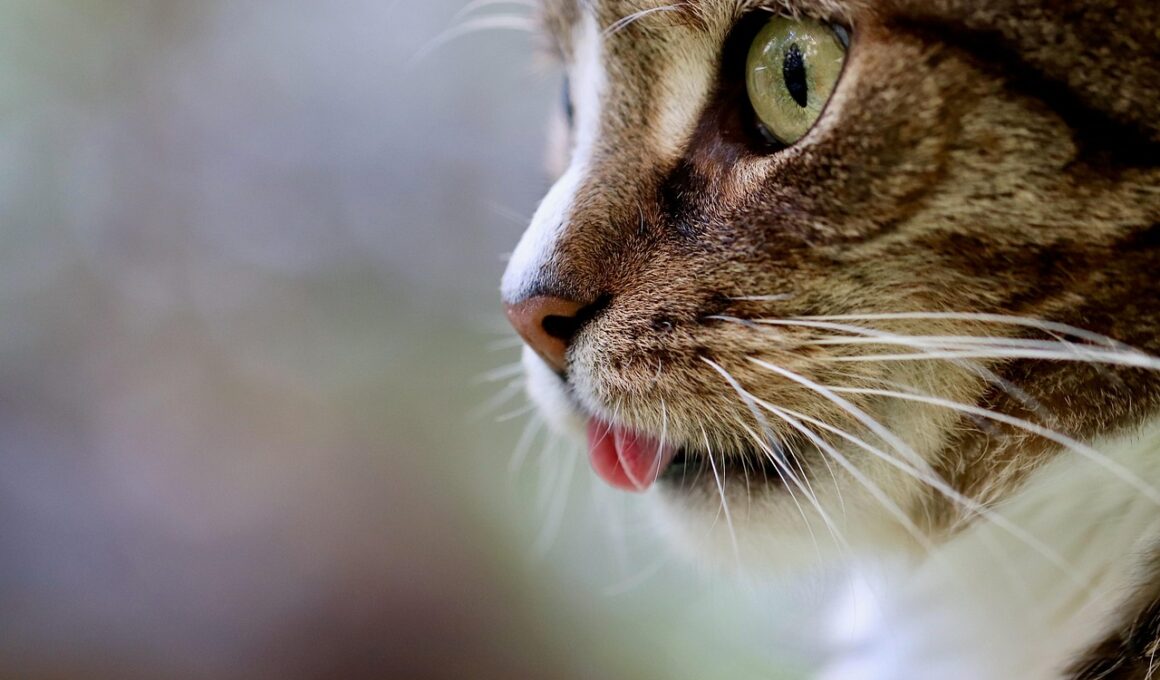How Cats Communicate Stress in Show Environments
Cats are sensitive creatures, and their behavior in show environments can reveal their stress levels. Understanding how cats communicate stress is essential for handlers and judges in these settings. Some common physical signs include flattened ears, twitching tails, and dilated pupils. These signals can indicate that the cat feels threatened or nervous. Additionally, vocalizations can differ significantly; hissing, growling, or yowling may accompany stressful situations. Recognizing these stress signals allows handlers to take steps to alleviate anxiety. For instance, providing a calming presence and comfortable space can make a difference. Handlers should also consider the overall atmosphere of the show, including loud noises and the presence of many other cats and people. Each cat has unique triggers that can elevate stress levels, and a knowledgeable handler will foster a more supportive environment. Maintaining calmness around the feline contestant will encourage better behavior and a positive experience for everyone involved. It’s also advisable for handlers to consult professional resources to better understand their cat’s individual needs during shows. Ultimately, recognizing stress signals in cats can significantly enhance their show experience, making it enjoyable for both the feline and its handler.
In addition to the physical manifestations of stress, cats may also exhibit behavioral changes that reflect their discomfort. For instance, a cat that typically enjoys being handled may suddenly withdraw or refuse to interact with its handler during a show. This change can be a clear signal that the environment is causing stress. Handlers must pay attention to these nuances and adapt their approach accordingly. Offering quiet moments away from the show floor can help alleviate some of the cat’s anxiety. Similarly, distractions such as toys or treats can serve as effective tools to redirect a cat’s attention during stressful periods. It’s crucial for handlers to not force interactions during these moments, as doing so can exacerbate the cat’s fear. Maintaining a routine helps reduce anxiety as well. When cats are accustomed to a schedule, they often feel more secure even in new environments like shows. This is particularly important during preparation or exhibiting phases. Handlers should strive to create familiar experiences amidst the chaos of a cat show. By doing so, the overall experience for the cat can be more positive and less overwhelming, facilitating better performance and minimizing stress responses.
Understanding Environmental Triggers
Various environmental factors contribute to a cat’s stress during shows, and understanding these triggers can help improve their experience. Loud noises from crowds, clanging equipment, and unexpected movements can all lead to heightened anxiety. It’s essential for handlers to evaluate the show environment before introducing their cat to it. Assessing the layout for potential stressors such as proximity to busy areas can be beneficial. Background noise levels can also fluctuate, impacting a cat’s comfort level. When attending a cat show, it’s advisable to arrive early so that the cat can acclimate to the new surroundings safely. Creating a secure space with the right bedding, familiar toys, and comforting scents may further ease the transition. An effective way to minimize external stress is to limit the number of visitors interacting with the cat before the show. While socialization is vital, too many unfamiliar faces can be overwhelming. Managing interactions ensures that the cat’s experience remains positive. Continuous monitoring of the cat’s stress signs allows handlers to implement strategies tailored to their feline’s unique responses. By recognizing these environmental triggers, handlers can significantly mitigate stress.
Another critical aspect to consider in understanding a cat’s stress response is the genetic predisposition for coping with anxiety. Some breeds may be naturally more resilient in stressful environments, while others may struggle significantly. For example, breeds like Ragdolls are typically more laid back and adaptable. In contrast, Siamese cats, known for their social nature, may experience anxiety in new situations more acutely. Handlers should take these breeds’ traits into account when preparing for a show. Knowledge of breed characteristics can guide the handler in implementing strategies that align with the cat’s inherent behavior. For example, a more anxious breed may require additional time and careful exposure to the show environment. Using calming aids like pheromone diffusers or stress-relief sprays can also be beneficial for cats that display notable stress. Handlers should not hesitate to invest in these aids to provide their feline companion with the best possible experience. The goal is to enhance the cat’s well-being, allowing it to thrive during the show. A deeper understanding of both stress signs and breed characteristics equips handlers to make informed decisions that positively impact show experiences.
Social Dynamics in the Show Environment
The social dynamics between cats during shows can also play a significant role in stress levels. Cats are generally solitary animals, and introducing them to numerous other cats in confined spaces can lead to heightened stress. Maintaining a safe distance from other competitors can help keep the anxiety at bay. Observing how other cats react, including their vocalizations and body language, provides clues into how individual cats perceive their environment. Handlers can significantly influence their cat’s attitude through their behavior and reactions; a calm demeanor from the handler can help the cat feel secure. Additionally, friendly interactions from humans can either reinforce or reduce stress. It’s essential for onlookers to respect the boundaries of each cat and allow them space, which also applies to other competitors. Provide an environment where cats have the option to retreat if feeling threatened, allowing them to choose between social interaction and solitude. This ensures that every cat has a sanctuary, generating a foundation for each participant’s comfort level during the show. Ultimately, understanding social dynamics aids in managing stress, enabling a successful showcasing of each cat’s talents.
Another key factor affecting cat behavior in shows is the training and preparation beforehand. Exposure to a variety of situations, sounds, and people can greatly equip a cat for the unpredictable nature of show events. By exposing cats to different environments prior to the show, handlers can help them develop coping strategies for stress. Routine positive reinforcement during these training sessions encourages confidence and reduces anxiety. Incorporating mock shows at home can familiarize cats with the entire experience, reducing uncertainty when it matters most. These proactive steps can lead to a decrease in stress-related behaviors. Likewise, socializing with both humans and other animals in controlled settings can provide another level of preparation that makes show situations appear less daunting. Engaging in preparatory measures can also help strengthen the bond between the handler and cat, fostering trust. This relationship creates a sense of security for the cat, allowing it to perform better in shows. In the end, thorough training is key to helping cats manage stress effectively during competitive events. When cats feel more prepared, they are less susceptible to stress responses, leading to an overall enhanced experience.
Conclusion: Prioritizing Cat Welfare
In conclusion, understanding how cats communicate stress during shows is vital for ensuring their well-being in these environments. As empathetic handlers, recognizing the signals that indicate discomfort can significantly enhance the overall experience for both cats and their owners. Key indicators, including body language, vocalizations, and environmental factors, all contribute crucial insights into a cat’s mental state during shows. By remaining vigilant and implementing strategies that minimize stress, handlers can foster a more secured environment for their pets. Additionally, considering genetic predispositions aids in tailoring responses that cater to specific needs. Social dynamics can play a vital role in shaping a cat’s comfort level; hence, supporting safe interactions or distance will create a more harmonious atmosphere. Moreover, effective preparedness through training and environmental exposure promotes comfort and reduces anxiety. Prioritizing cat welfare should always be at the forefront of a handler’s objectives. Cats provide joy and companionship and deserve to feel secure and confident at shows. With empathy and understanding, we can create positive experiences that support cats throughout their show endeavors, ultimately enriching their lives beyond competitions.


